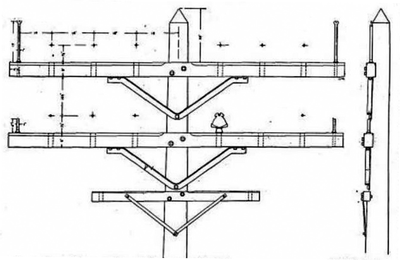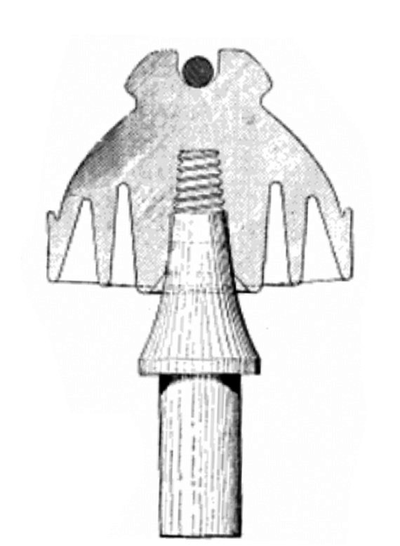[Trade Journal]
Publication: Electrical Review
New York, NY, United States
vol. 29, no. 6, p. 61-62, col. 1, 1-2
THE TRANSMISSION OF ELECTRIC POWER FROM NIAGARA FALLS TO BUFFALO.
IN NOVEMBER NEXT THE FIRST POWER WILL BE TRANSMITTED AND WILL BE USED BY THE BUFFALO RAILWAY COMPANY - A TRANMISSION LINE OF UNUSUAL IMPORTANCE - AN EXAMPLE OF FINE ENGINEERING.
For some time past there have been rumors that electric power was soon to be transmitted from the plant of the Niagara Falls Power Company, at Niagara Falls, N. Y., to be used in Buffalo, N. Y. It took some time to secure the proper right of way, and as the work involved was of an original and novel character, considerable time and thought was devoted to the consideration of the best means for carrying the current. A few weeks ago the Cataract Construction Company made a contract with the White-Crosby company, of 29 Broadway, New York city, for the complete design and construction of the transmission line. An unusual amount of special designing has been required, and this the White-Crosby company has carried out with its well known engineering ability and thoroughness. Mr. J. G. White has devoted his personal attention to the matter, and his efficient corps of assistants has rendered him worthy aid. Work will be commenced at once, and, when finished, the line will have cost in the neighborhood of [dollar: $500,000]. This is one of the most important electrical engineering contracts ever begun, and the reputation of the firm which has it in charge assures its success.
 |
| Fig. 1. - Top of Pole and Fixtures Used on the Electric Transmission Line Which Will Supply Niagara Falls Current to Buffalo, N. Y. |
The accompanying drawings will give a very good idea of the appearance of one of the poles and its fixtures used in the line and of the special type of insulator employed. The poles are of round cedar, shaved and painted, with 9 and 10-inch tops. The length will vary from 35 to 50 feet, depending on the soil and the requirements of the line. The cross-arms are of hard, yellow pine, 4 inches, chamfered and painted. The short arm, shown in Fig. 1, is a standard six-pin electric light arm bored for two pins. This cross-arm will carry a private telephone line from the power house at Niagara Falls to the transformer station in the city of Buffalo. The cross-arm braces have been specially designed and possess several points of novelty. They are made of two and one-half by one-quarter inch angle iron, formed hot and bored for lag screws. The angles weigh about 20 pounds apiece and are primarily designed to act as trusses. As will be seen in the drawing, the bearing surfaces are on the under side of the cross-arm. The cross-arms are gained into the poles and are fastened with two lag screws staggered.
The pins shown on the extremities of the lower, long cross-arm are steel guards to prevent any of the conductors from falling in case a tie-wire, pin or insulator breaks. The long steel pins on the top cross-arm are for a similar purpose and also to carry the galvanized iron barbed fence wire, which will be used as a lightning conductor. Another conductor of the same kind will be carried on top of the poles. At every fifth pole these lightning conductors are grounded to a coil of wire buried at the foot of the pole.
Each conductor of the transmission line is of 350,000 circular mils stranded bare copper wire. When the line is completed there will be 12 of these conductors. Each pole will then carry a weight of 1,200 pounds of copper. The mechanical strains to which the pole and lines may be subjected have been calculated with the greatest nicety. These calculations have been carried to the extent of assuming the whole line to be covered with one-half inch of ice.
This transmission line will run over a private right of way from the Niagara Falls Power Company's station at Niagara Falls to Tonawanda, and thence down one bank of the Erie Canal to Buffalo. The entire line will be fenced in.
The induction effects will be over-come by a transposition of the conductors from pole to pole. The phase of this transposition is such that the entire line is shifted on five poles.
 |
| Fig. 2. - Special Type of Porcelain Insulator Used on Niagara Falls-Buffalo Transmission Line. |
%%The insulator to be used on the line is, as will be seen from Fig. 2, of a special and novel design. It is made of porcelain, and so proportioned as to protect all weak points. Uniform strength and a large insulating surface have been assured. Along the lower edge of the outside petticoat is a gutter, designed to drain away water on each side clear of the cross-arm. The construction of the insulator and gutter is such that icicles are compelled to form at only two points, both clear of the cross-arm.% %
The total capacity of the transmission line will be 20,000 horse-power. The current will be three-phase alternating, and each half of each of the long cross-arms will support three wires, carrying 5,000 horse-power. The contract calls for the completion of this line by November 15, but the White-Crosby company expect to be able to deliver 5,000 horse-power of current in Buffalo on or before November 1. The arrangements have all been made, by which the Buffalo Railway Company will take the first 1,000 horse-power delivered in the city.
The transmission line is being built by the White-Crosby company for the Cataract Construction Company. When it is completed the latter company will turn it over to the Niagara Falls Power Company, whose final property it becomes.
The Niagara Falls Power Company will generate the current at the Falls and send it over the line to the city limits of Buffalo. It will here be delivered to a sub-company of the Niagara Falls Power Company, known as the Cataract Power and Conduit Company. The latter is the distributing company in Buffalo. Its president is Mr. George Urban, Jr., and Mr. Charles R. Huntley is its vice-president and general manager. The capital of the company is [dollar: $2,000,000], and its board of directors is as follows: E. D. Adams, John Jacob Astor, D. O. Mills, Daniel O'Day, William B. Rankine, Francis L. Stetson and Edward L. Wickes, of New York, and Charles R. Huntley and George Urban, Jr., of Buffalo.
